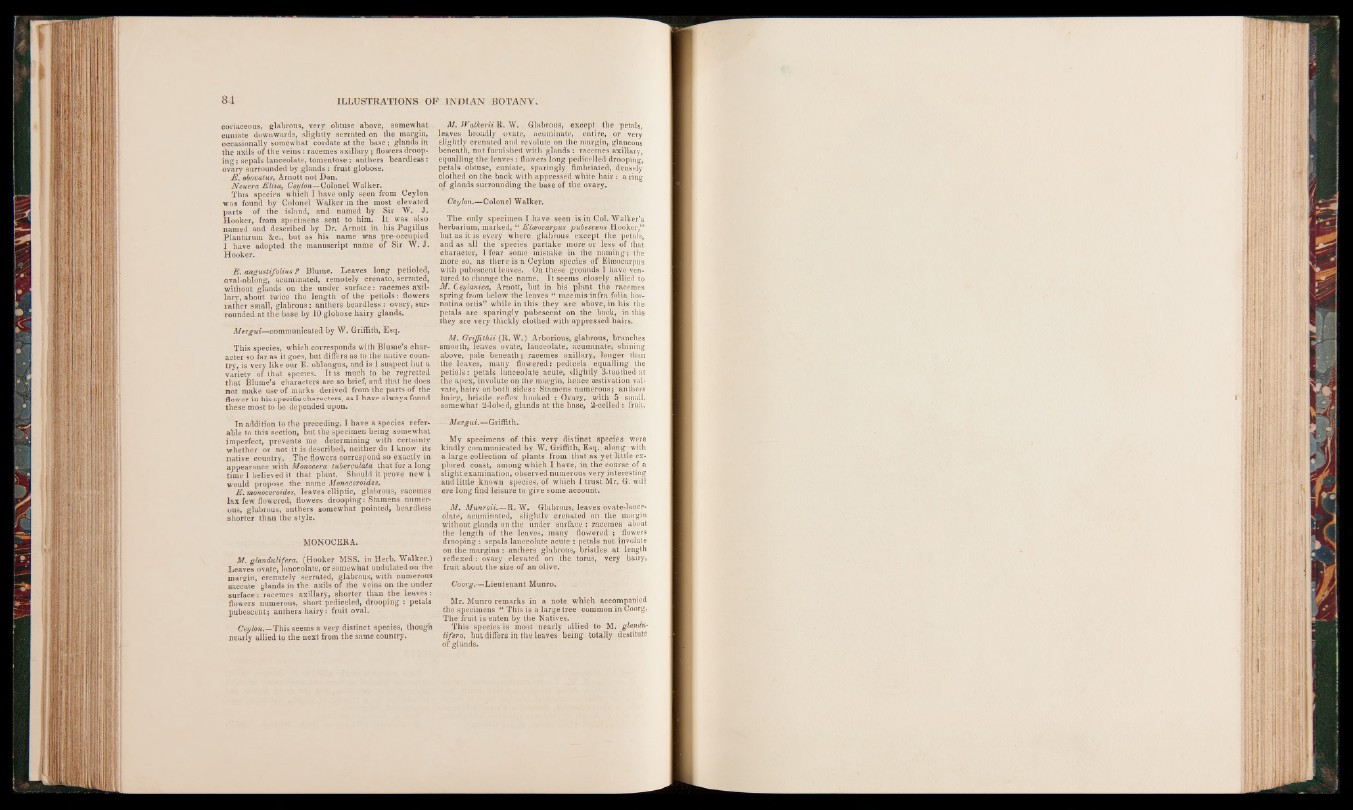
coriaceous, glabrous, very obtuse above, somewhat
cuniate downwards, slightly serrated on the margin,
occasionally somewhat cordate at the base; glands in
the axils of the veins: racemes axillary; flowers drooping
; sepals lanceolate, tomentose: anthers beardless:
ovary surrounded by glands: fruit globose.
E . obovatus, Arnott not Don.
Neuera Ellia, Ceylon—Colonel Walker.
This species which I have only seen from Ceylon
was found by Colonel Walker in the most elevated
parts of the island, and named by Sir W. J.
Hooker, from specimens sent to him. It was also
named and described by Dr. Arnott in his Pugillus
Plantarum &c., but as his name was pre-occupied
I have adopted the manuscript name of Sir W. J.
Hooker.
E . angustifolius ? Blume. Leaves long petioled,
oval-oblong, acuminated, remotely crenato, serrated,
without glands on the under surface: racemes axillary,
about twice the length of the petiols: flowers
rather small, glabrous: anthers beardless : ovary, surrounded
at the base by 10 globose hairy glands.
Mergui—communicated by W. Griffith, Esq.
This species, which corresponds with Blume’s character
so far as it goes, but differs as to the native country,
is very like our E. oblongus, and is 1 suspect but a
variety of that species. It is much to be regretted
that Blume’s characters are so brief, and that he does-
not make use o f marks derived from the parts of the
flower in his specific characters, as I have always found
these most to be depended upon.
In addition to the preceding, I have a species referable
to this section, but the specimen being somewhat
imperfect, prevents me determining with certainty
whether or not it is described, neither do I know its
native country. The flowers correspond so exactly in
appearance with Monocera tuberculala that for a long
time I believed it that plant. Should it prove new I
would propose the name Monoceroides.
E . monoceroides, "leaves elliptic, glabrous, racemes
lax few flowered, flowers drooping: Stamens numerous,
glabrous, anthers somewhat pointed, beardless
shorter than the style.
MONOCERA.
M. glandulifera. (Hooker MSS. in Herb. Walker.)
Leaves ovate, lanceolate, or somewhat undulated on the
margin, crenately serrated, glabrous, with numerous
saccate glands in the axils of the veins on the under
surface: racemes axillary, shorter than the leave s:
flowers numerous, short pediceled, drooping : petals
pubescent; anthers hairy: fruit oval.
Ceylon.—This seems a very distinct species, though
nearly allied to the next from the same country.
M. fValkerii R. W. Glabrous, except the petals,
leaves broadly ovate, acuminate, entire, or very
slightly crenated and revolute on the margin, glaucous
beneath, not furnished with glands : racemes axillary,
equalling the leaves: flowers long pedicelled drooping,
petals obtuse, cuniate, sparingly fimbriated, densely
clothed on the back with appressed white hair : a ring
o f glands surrounding the base o f the ovary.
Ceylon.—Colonel Walker.
The only specimen I have seen is in Col. Walker’s
herbarium, marked, “ Elceocarpus pubescens Hooker,”
but as it is every where glabrous except the petals,
and as all the species partake more or less of that
character, I fear some mistake in the naming; the
more so, as there is a Ceylon species of Elseocarpus
with pubescent leaves. On these grounds I have ventured
to change the name. It seems closely allied to
M. Ceylanica, Arnott, but in his plant the racemes
spring from below the leaves “ racemis infra folia hor-
notina ortis” while in this they are above, in his the
petals are sparingly pubescent on the back, in this
they are very thickly clothed with appressed hairs.
M. Griffilhii (R. W.) Arborious, glabrous, branches
smooth, leaves ovate, lanceolate, acuminate, shining
above, pale beneath; racemes axillary, longer than
the leaves, many flowered: pedicels equalling the
petiols: petals lanceolate acute, slightly 3-toothed at
the apex, involute on the margin, hence aestivation val-
vate, hairy on both sides: Stamens numerous; anthers
hairy, bristle reflex hooked : Ovary, with 5 small,
somewhat 2-lobed, glands at the base, 2-celled: fruit.
— Mergui.—Griffith.
My specimens of this very distinct species were
kindly communicated by W. Griffith, Esq. along with
a large collection of plants from that as yet little explored
coast, among which I have, in the course of a
slight examination, observed numerous very interesting
and little known species, of which I trust Mr. G. will
ere long find leisure to give some account.
M. Munroii.—R. W. Glabrous, leaves ovate-lanceolate,
acuminated, slightlv crenated on the margin
without glands on the under surface : racemes about
the length of the leaves, many flowered ; "flowers
drooping : sepals lanceolate acute : petals not involute
on the margins : anthers glabrous, bristles at length
reflexed: ovary elevated on the torus, very hairy,
fruit about the size of an olive.'
Coorg.—Lieutenant Munro.
Mr. Munro remarks in a note which accompanied
the specimens “ This is a large tree common in Coorg.
The fruit is eaten by the Natives.
This species is most nearly allied to M. glandulifera,
but differs in the leaves being totally destitute
of elands.